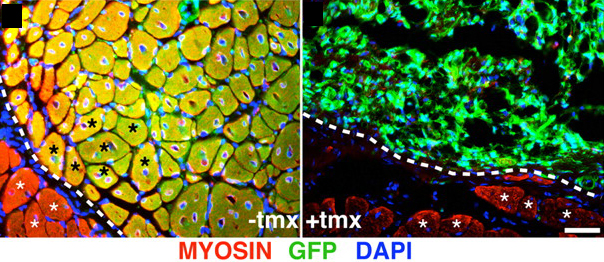Satellite cells muscle their way into the stem cell spotlight
Posted by Erin M Campbell, on 8 September 2011
 Researchers have long known about regeneration of injured muscles, and have debated about the exact source of the muscle stem cells that perform this amazing feat. A group of papers in a recent issue of Development shine a stem cell spotlight on satellite cells.
Researchers have long known about regeneration of injured muscles, and have debated about the exact source of the muscle stem cells that perform this amazing feat. A group of papers in a recent issue of Development shine a stem cell spotlight on satellite cells.
Following injury, skeletal muscles are regenerated by muscle stem cells, but the exact identity of these stem cells has been unclear. Recent research on muscle repair has focused on satellite cells, and clarifies their role as muscle stem cells. Satellite cells are found sandwiched in between the membranes of individual muscle fibers and the basement membrane, and can be identified by the presence of Pax7. Lepper and colleagues genetically ablated Pax7+ satellite cells in the muscles of mice using an inducible system and found that ablation of these cells prevented regeneration following cardiotoxin-induced injury. These results show that satellite cells are absolutely necessary for muscle regeneration. Images above show degenerated muscle grafts transplanted into healthy muscle tissue in nude mice. Lepper and colleagues used this technique to circumvent the lethality of their induced system after satellite cell ablation, allowing for the longer-term study of muscle regeneration. Control tissue (left, green) grafted into a healthy muscle bed was able to regenerate, as seen as the presence of myosin (red + green = yellow). After satellite cell ablation, grafted tissue (green) was unable to regenerate.
For a more general description of this image, see my imaging blog within EuroStemCell, the European stem cell portal.
Check out a summary of all four papers on muscle regeneration in Development here.
![]() Lepper, C., Partridge, T., & Fan, C. (2011). An absolute requirement for Pax7-positive satellite cells in acute injury-induced skeletal muscle regeneration Development, 138 (17), 3639-3646 DOI: 10.1242/dev.067595
Lepper, C., Partridge, T., & Fan, C. (2011). An absolute requirement for Pax7-positive satellite cells in acute injury-induced skeletal muscle regeneration Development, 138 (17), 3639-3646 DOI: 10.1242/dev.067595


 (3 votes)
(3 votes)